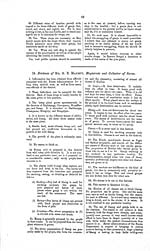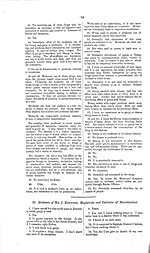Medicine - Drugs > Report of the Indian Hemp Drugs Commission, 1894-1895 > Volume IV
(67) Volume 4, Page 53
Thumbnail gallery: Grid view | List view

53
plants may also cause the
decrease in the use of
this drug.
26. (a) 40 per cent.
(b) 20 "
(c) 25 "
(d) 15 "
Ganja.
(a) 50 "
(b) 10 "
(c) 25 "
(d) 15 "
Bhang.
27. Hindus of
all classes, Brahmins, Rajputs,
and Bhúinhars and mendicants, as a rule, form the
consumers of ganja and bhang. Of these the
rich and well-to-do class use these drugs for
pleasures' sake; the labouring class to alleviate
fatigue; and the mendicants to concentrate their
thoughts. Bhang also is sometimes used for
medicinal purposes.
28. (a) Half anna per diem
(b) Four annas "
Ganja.
(a) Three pies "
(b) Six " "
Bhang.
29. (a) Ordinarily
tobacco leaf is mixed with
ganja; (b) rose water and flower are also used
with it for flavour. Dhatura is not used with
ganja. Tobacco is used with ganja to make it suit
the taste, and also to weaken its effect.
Bhang. (a) Black paper is
ordinarily used with
bhang; (b) bhang massala, sugar, and milk. Dha-
tura is not used with it.
Bhang massala. We know of the
preparation
called "bhang massala." Its ingredients are
aniseed, kasni, rose flower, and seed of cucumber
and melon. The object of the admixture is to
have a cooling effect and agreeable taste.
30. Bhang. The extent of
its consumption is
the same in solitude as in company. it is confined
to the male sex. Children do not use it.
Ganja. In company ganja is
consumed con-
siderably more than in solitude. Yes; it is main-
ly confined to the male sex above the age of 15.
31. The habit of consuming ganja
and bhang is
easily formed, and it is difficult to break it when
formed. There is a tendency in the case of each
of these two drugs, like alcoholic drink, for the
moderate habit to develop into excess.
32. With the Hindus it is a
social custom in
Holi to consume ganja and bhang as well as other
intoxicants. It is not essential. It is not likely
to lead to the formation of the habit. In the
Holi time the excessive use of the drugs some-
times proves injurious.
33. The public generally look
down upon the
consumers of the drugs. There is not any live
public opinion, social or religious, in regard to the
practice. The use of this narcotic in any form is
in disrepute; the sentiment is attributable to the
fact that the moderate habit frequently develops
into the excessive, which ultimately leads the con-
sumers to ruin. There is no custom of worship-
ping the hemp plants.
34. In the case of ganja it would
be a serious
privation to habitual consumers to give it up.
The reason simply is this, that they have contract-
ed the habit, the discontinuance of which, it is
said, would tell heavily upon their constitution.
The same may be said in the case of bhang. Pro-
bable number of such sufferers would be thus:—
For ganja, 20 per cent.
For bhang, 5 " "
35. It would not be feasible to absolutely pro-
hibit the use of ganja and bhang. If it is done,
it would be consumed illicitly to a great extent.
The prohibition can only be enforced by stopping
the cultivation and wild growth of these drugs in
the districts where they grow, but the prohibition
of the wild growth of bhang is not very easy in
this district, as it grows spontaneously in unfre-
quented places. The prohibition, if effected,
would cause discontent to a large extent amongst
the habitual consumers, especially the Sadhu class.
Perhaps there is not any serious political danger.
About this point Mr. Tytler, Sub-Deputy Opium
Agent at Siwan, was consulted, whose opinion
must be considered very valuable from his long
residence in this district (about 20 years) and
from the special opportunities he has had to know
about the tendencies of the people. He is decided-
ly of opinion that an absolute prohibition of
the use of the drugs would be attended with poli-
tical danger. His argument is that the Sadhus
and Brahmins and Rajputs holding some position
in society chiefly form the consumers of the drugs.
They will be greatly discontented when deprived of
the use of the drugs, and naturally all the other
classes of the Hindus with whom these consum-
ing classes wield considerable influence will sym-
pathise with them. There is no doubt that the
habitual consumers when deprived of the use of these
drugs will raise a yell of discontent which may oc-
casion disturbances. The prohibition may be fol-
lowed by recourse to an inappreciable extent to
(a)
alcoholic stimulants, because the upper class
of
Hindus and the mendicants (Sadhus) who are given
to the use of these drugs would not have recourse
to alcoholic stimulants, as they do not harmonise
with their sentiments.
(b) No other drugs can replace ganja
and
bhang.
36. We have no reason to think so. The two
drugs are cheaper than the weakest country liquor
supplied to consumers. A pie worth of ganja
would be more effective than one anna worth li-
quor.
37. The effects are almost the same, but that
produced by charas is somewhat greater.
38. No.
39. The smoking of any preparation of hemp
plant is less injurious than drinking or eating the
same. In smoking, the ingredients of ganja are
made volatile and remain within the system for a
short period, and then eliminate easily through
the respiratory tract, and hence have less effect.
As regards bhang-smoking, which is rarely used,
the effect is considerably less than that produced
in the form of drinking or by taking it in the shape
of boluses.
40. Bhang and ganja are used by native
doctors for medicinal purposes in chronic inter-
mittent fevers.
Bhang is used in the treatment of cattle disease.
41. Moderate use of bhang (a) is beneficial
as
a digestive; (b) and acts as a stimulant after
fatigue; (c) and both of them (bhang and ganja)
are considered as a febrifuge or preventive to
malaria; (d) and moderate doses of both of them
stimulate virile power.
Hindus of all classes, specially the upper ones,
as Rajputs, Brahmins, etc., are addicted to ganja
and bhang in the proportion of five in every
thousand. This refers to the moderate habitual
use of the drugs.
Set display mode to: Large image | Zoom image | Transcription
Images and transcriptions on this page, including medium image downloads, may be used under the Creative Commons Attribution 4.0 International Licence unless otherwise stated. ![]()
| India Papers > Medicine - Drugs > Report of the Indian Hemp Drugs Commission, 1894-1895 > Volume IV > (67) Volume 4, Page 53 |
|---|
| Permanent URL | https://digital.nls.uk/74552384 |
|---|---|
| Description | Evidence of Bengal witnesses. |
| Description | Volume 4: Evidence of witnesses from Bengal and Assam. |
|---|---|
| Attribution and copyright: |
|




